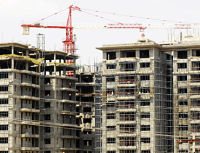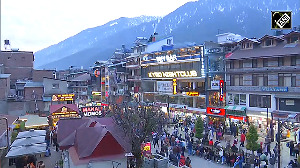It's a race among real estate developers to complete a floor quicker than the rest. With timely delivery of projects turning into a selling point, innovative technology is being put to use by realtors like never before. Raheja Developers, which recently tied up with Dubai-based Arabtec Constructions, would be using a combination of various technologies for three highrise residential projects in Gurgaon and Delhi.
Raheja Developers, which recently tied up with Dubai-based Arabtec Constructions, would be using a combination of various technologies for three highrise residential projects in Gurgaon and Delhi.
Expected to be the tallest tower in Gurgaon, the construction of a 60-floor Raheja Revanta will involve using three major techniques, 'slip form construction', 'pre-fabricated construction' and 'dry-wall technique'.
Supertech, building an 80-floor mixed use building, Supernova, in Gurgaon, which it claims would be the tallest in the country, will be using a jump-form or slip form technology imported from Australia.
Raheja Developers' Director Nayan Raheja said slip form construction would enable them to build a floor in just three to four days, as against 15 days using traditional technology. "Slip form will take only one fifth of the time of what the traditional technique takes," he said.
Concrete is poured into a continuously moving form that enables continuous, non-interrupted, cast-in-place "flawless" (no joints) structures, which have superior performance characteristics versus piecewise construction using discrete form elements.
R K Arora, chairman and managing director, Supertech, told Business Standard, the technique would help them do a floor in just seven days.
Pre-fabricated construction includes doing electrical and plumbing work at the stage of casting RCC (reinforced cement concrete) on ground, which developers are starting to use these days. It is expected to cut construction time by more than half, Arora said.
"However, it has its disadvantage," said Raheja. "As plumbing and electrical work can't be changed at a later stage, we have to be very careful." Yet, prefabricated construction is gaining pace in India, with many developers going for it.
"Developers are using steel frames to build a structure and then to do the interiors with prefabricated structures," said Samarjit Singh, CEO, Agni Properties.
A dry-wall technique involves constructing interior walls, ceilings and floors through plastered or microfibre board, joined during the installation.
Apart from offering sound control, dry-wall construction can also make an interior space fire-resistant and damp-resistant.
"A dry-wall technique is easier, faster and more economical compared to the traditional technique of hand plastering," Raheja said.
Arora, however, calls the dry-wall technique an expensive one in India at the moment, as it involves sound proofing, which is not economical. "However, it definitely ensures quick completion of projects," he said.
Raheja says construction techniques in India are nearly 20 years behind the Western world. "In the West, clay brick is out of construction; in India, we still use it." He said innovative construction techniques would also add 10 per cent to construction cost.
Supertech has a business development department which keeps a watch on innovation and construction techniques around the world.
Anshuman Magazine, chairman and managing director, CB Richard Ellis (South Asia), said developers in India are importing advanced construction technology in order to maintain competitive edge in the market.
"Today, customers' focus is on who delivers the project on time, which has become a selling point for the developers." Also, a lot of highrise buildings are coming up, where one can't do without the use of technology.
Singh said with the focus also shifting towards affordable housings, developers are cutting costs using improved and innovative construction techniques for quicker completion.
"Jerry Rao's VBHC, an affordable housing project in Bangalore, is also focusing on using technology to build affordable homes at Rs four to six lakh, while promising delivery within six months from starting construction".
Singh believes that the use of technology will only grow in the coming years, letting developers complete projects in just three to four months.










 © 2024 Rediff.com -
© 2024 Rediff.com -